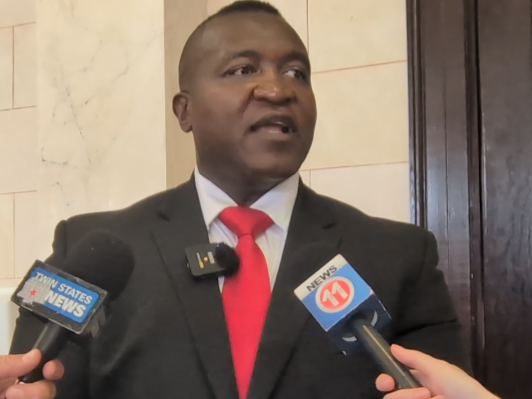Okatibbee plays major role in flood control
Published 4:30 pm Friday, April 5, 2019

- Whitney Downard / The Meridian StarNick Angevine, a natural resource specialist with the U.S. Army Corps of Engineers, surveys the access bridge, where the USACE monitors the flow and water levels of Okatibbee Dam.
Flooding along the Mississippi Delta has submerged hundreds of thousands of acres, leaving families and farmers stranded in the last two months.
Gov. Phil Bryant has asked President Donald Trump’s administration to consider a flood control and drainage project for the region, coinciding with a prediction from the National Oceanic and Atmospheric Administration’s forecast of major to moderate spring flooding across the Midwest. NOAA predicts minor flooding for most of East Mississippi and moderate flooding for Central Mississippi.
With 211 dams in Lauderdale County alone, according to the Mississippi Department of Environmental Quality, 33 dams are “high hazard,” meaning “dam failure may cause loss of life, serious damage to homes, industrial or commercial buildings, important public utilities, main highways or railroads.”
Flood control
The biggest dam in Lauderdale County, Okatibbee Dam, spans more than 6,500 feet and stands 61 feet above the surrounding creek bed. Managed by the U.S. Army Corps of Engineers, six people monitor the site.
“Our mission is flood control; that’s the purpose of Okatibbee Lake,” Scott Payne, a Supervisory Natural Resource Manager with the USACE, said. “Every day we do a pool read and check the elevation of the upper lake… Somebody puts their eyes on the dam every day.”
Information from sensors and on-the-ground reports goes to Mobile, Alabama, where water management staff combine the data and monitor water levels from Slidell, Louisiana to Lake Seminole, Florida.
Once a month, hydraulic technicians Glenn Duval and Joe Stuart, both based in Mobile, tour USACE-monitored sites, replacing damaged sensors and checking data readings.
“Mobile District is one of the largest district that the corps has,” Duval, a 41-year veteran of the Corps, said. “Our watershed is tremendous.”
A box, about the size of a large dog crate, hovers over the Okatibbee River off of a bridge within the shadow of the dam. Duval and Stuart replaced a sensor damaged by lightning so the box would seamlessly transmit flow data to their Mobile office.
“All of this is pretty vital,” Stuart said. “But a lot of people don’t know what’s in these boxes.”
The 50-year-old dam, considered high hazard, is the northern tip of the Pascagoula River Basin, which flows in the Gulf of Mexico, and “reduces flood damage on 26,000 acres of residential, industrial and agricultural lands along Okatibbee Creek and upper Chickasawhay River at Meridian and Stonewall,” according to an Okatibbee Dam pamphlet.
Monitoring includes checking piezometers, or tubes inserted into the dam, to measure water. With an earthen dam, water naturally seeps through but unusual numbers can indicate excess water infiltration or water pressure, Payne said.
“Mowing the grass isn’t the only thing we’re doing here – we’re keeping an eye on everything else,” Payne said.
More than recreation, the team at Okatibbee Dam also bears the responsibility of monitoring rainfall for the region and measuring the effect on outflow. Two downstream monitors, on Old Highway 80 and Arundel Road, send even more measurements back to the office on Okatibbee Lake.
“Everything’s been historically plotted out within the water manual,” Nick Angevine, a natural resource specialist, said. “We know what we can handle.”
Having a plan
During the flooding in December, Payne and Angevine eyed the forecast, predicted seven-to-eight inches of rain, which would flood parts of the campground.
Instead, the majority of the storm hit the southern region, blocking many roadways and damaging bridges.
“We were concerned about the water level and rain at seven, eight inches but we didn’t get the rain in our basin. We got about four inches,” Payne said. “But, we were able to hold (our water level) in the lake until they had some relief (downstream).”
“We have to be cognizant of what’s going on downstream before we do anything upstream,” Angevine said.
MDEQ routinely inspects dams, such as Okatibbee, and releases their EAPs, or emergency action plans, online. Ten dams in Lauderdale County are high-hazard dams and don’t have EAPs.
Okatibbee’s EAP outlines the numbers of emergency personnel to call and lists various homeowners who may be affected.
“The plan is very important to notify emergency personnel and the residents. If we notice a problem, we get on the horn,” Payne said. “You don’t want to ask ‘What are we going to do?’ You want to know.”
Payne said his team held exercises last year to prepare for continuous rain over a period of time or a sudden deluge, both instances where water may suddenly rise at the lake.
“The one we fear the most is dam failure,” Payne said.
An inundation map from the dam’s EAP outlines the impact of a major dam failure, where the dam breached and water flowed at 100 times the normal level, Payne said, reviewing the plan.
Water flow of that magnitude would stretch south along the Okatibbee and Chickasawhay Rivers, flooding homes and businesses along Highway 19, Key Field and down into Enterprise.
“It normally takes 24 hours to release and (hit) our river gauges downstream (at Arundel Road),” Payne said. “According to this, it would take approximately six hours to reach Key Field.”
Payne noted that several developments had blossomed since the last map update. But, he said, even in times of minor water increase from the spillway, they contacted residents.
“Before we release our alarm, we contact farmers who might have cows in pasture,” Payne said.
Payne said that the historical flooding of the Easter floods in 1979 was a record high for the dam, an event which submerged many buildings in Jackson.
“That was the highest it’s ever been and it still didn’t go over,” Payne said.
Though fishermen flock to the shores of Okatibbee nearly every day, many might not realize the lake serves a greater purpose in flood control, constantly monitored to protect the lives and property of those in its watershed.
“Many people come here and don’t have clue that this place is here,” Angevine said. “We’re the eyes and ears of Okatibbee.”





